An extraordinary creative who pushes the boundaries of what is considered as permanence in art, Dain Yoon, a Seoul-born and New York-based optical illusion artist, is known for her unique approach to painting, where her body becomes both the canvas and the focus of her work. With her distinctive and deeply human style, she has represented some of the world’s most iconic brands and institutions—including Samsung, Instagram, Facebook, Netflix, Snapchat, The New York Times, the Van Gogh Museum, and the Seoul Metropolitan Government—proving that even the most ephemeral art can leave a powerful, lasting impression.
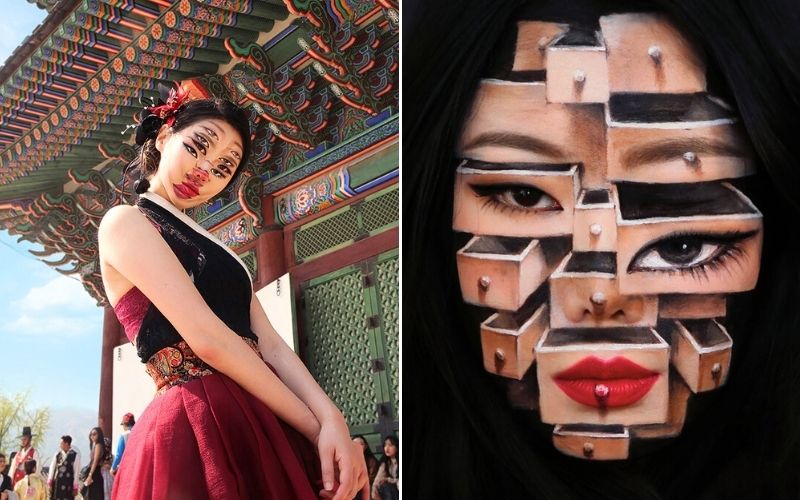
Dain Yoon sometimes adds eyes to her face, enabling her to see the world through a new perspective. Other times, she blends seamlessly with her background, becoming one with the moment—a living, breathing part of the scene. Her work is ephemeral, yet it leaves a lasting impression, showing us that beauty does not have to be permanent to be meaningful.
She challenges the idea that visual arts must exist on paper or canvas. Her body becomes the medium, and once the paint is removed, the artwork is eternally gone—never to be recreated the same way again. A photograph may remain, but the piece itself no longer exists. It feels like losing a person: even if their image stays, their essence and presence are gone. This transience, however, becomes a powerful form of expression.
In an era where artificial intelligence and digital tools can mimic almost any type of art, Yoon’s art stands as a powerful counterpoint. At first glance, some viewers assume her work is created with AI or enhanced with Photoshop because of its surreal perfection. However, that very assumption proves her point: her art is so precise, yet so human, it confuses even the most modern eyes. Perhaps in a future where AI is deemed to replicate everything, it will be human impermanence that holds the greatest value. Dain Yoon’s art, with its fleeting presence and undeniable emotional weight, reminds us that the most precious creations are the ones that cannot be repeated or artificially reproduced outside our physical human realm.
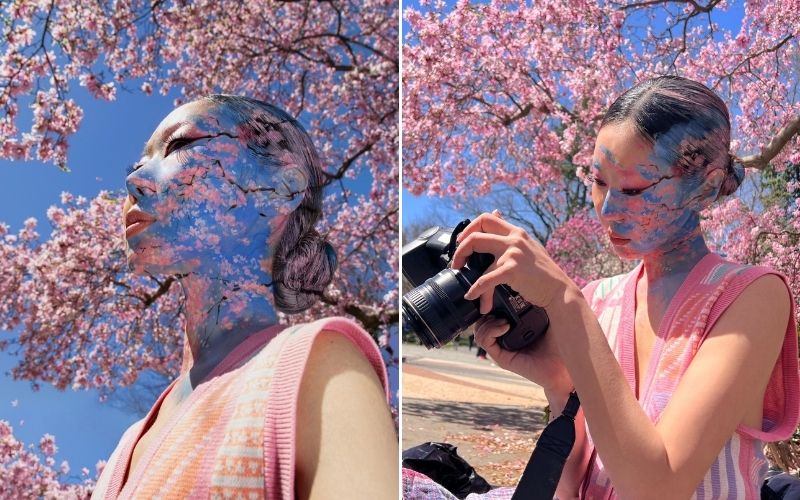
During my interview with Dain, she talked about a stunning design where cherry blossoms were painted on her face, seamlessly continuing from the blossoms existing in the background. This captivating work, just as it caught my eye, quickly drew the attention of millions across the social media platforms and has been liked and shared by thousands. Originally, she had actually planned to create this piece in Korea during the cherry blossom season, inspired by the beauty of places such as the Gyeongbokgung Palace. However, when her plans could not unfold as expected, she brought her vision to life in New York, at The Brooklyn Botanic Garden instead. The design received widespread recognition, including a feature from the garden itself and support from Instagram’s official account.
It is always inspiring when an artist finds a way to express their vision despite challenges, creating works that transcend borders and speak to people across the globe. One day, if you find yourself in Korea during cherry blossom season, wandering through the gardens of a palace or a place where history and modernity intertwine, you may come across Dain herself—her art blooming alongside the flowers—offering a moment where imagination and tradition beautifully converge.
In this special interview, Dain gracefully shares her world, her creative spirit, and the heart behind her awe-inspiring work, letting us dive into her unique journey and artistic vision, as she talks about her personal story and insights with Korea.net readers.
This interview was conducted in written form via email between March 5 and April 22.
Could you tell us about your childhood and how your journey as an artist began?
As a child, I was a bit eccentric, though I wouldn't necessarily describe myself as particularly artistic. I had an overwhelming curiosity about all sorts of strange things, like how long I could keep my eyes open in shampoo water or how I could run as fast as a rat!
Growing up, I received a lot of education in the arts and always enjoyed painting, which I was actually best at. I graduated at the top of my class from both Yewon Arts Secondary School and Seoul Arts High School. Later, I decided to study scenography at university, drawn to the idea of becoming a production designer for films. During my studies, I had the opportunity to design theatrical makeup and paint on actors' bodies.
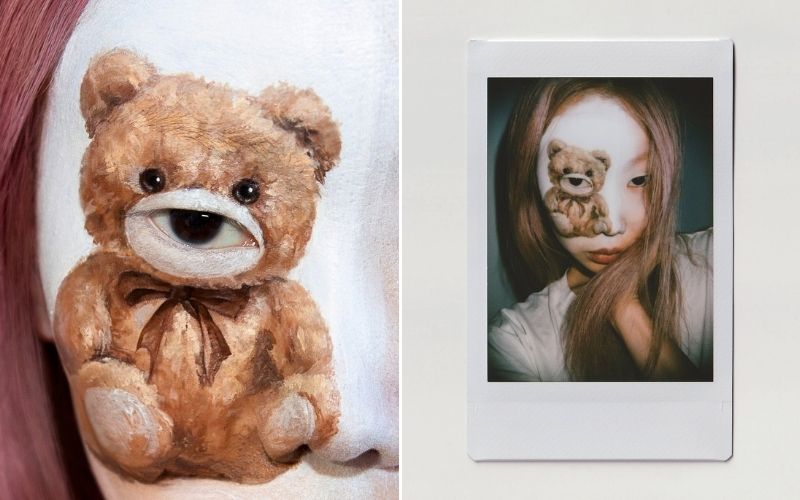
After some time with theatrical makeup, I felt the need to pursue my own creative work outside the theater. This shift began around 2014. Initially, I painted on the bodies of models, but eventually, I chose to focus on my own face. I saw the face as the most powerful and sensitive part of the body and using it as my canvas allowed me to express my most delicate emotions in a truly personal way. In many ways, my style developed organically, blending my experiences in fine art, theatrical makeup, stage design, photography, performance, and even modeling. Combining these different fields felt natural, thanks to my background in each of them, and it ultimately contributed to the deeply personal nature of my work.
As an optical illusion artist, you transform your body and face into a canvas that blends with the architectural structures and your surroundings. Growing up with an artist mother and an architect father, do you think that their professions have intentionally or perhaps subconsciously shaped and developed your artistic approach?
I love how this question draws a connection between my parents’ backgrounds and the style of my illusion paintings! While I don’t think my dad’s architecture profession directly influenced my camouflage art, it's an interesting perspective on the impact my parents have had on me, possibly in ways I haven't even realized.
Growing up, my mom always emphasized the importance of humor in art. She was a prolific painter and always thinking outside the box. I'm grateful that she passed down this mindset, along with a strong work ethic, which was crucial in the early stages of my career and continues to drive me to create new work. One aspect of my personality I attribute to my dad is my inner strength. Throughout life, I've faced many stressful or difficult moments, but his fortitude has helped me overcome them.
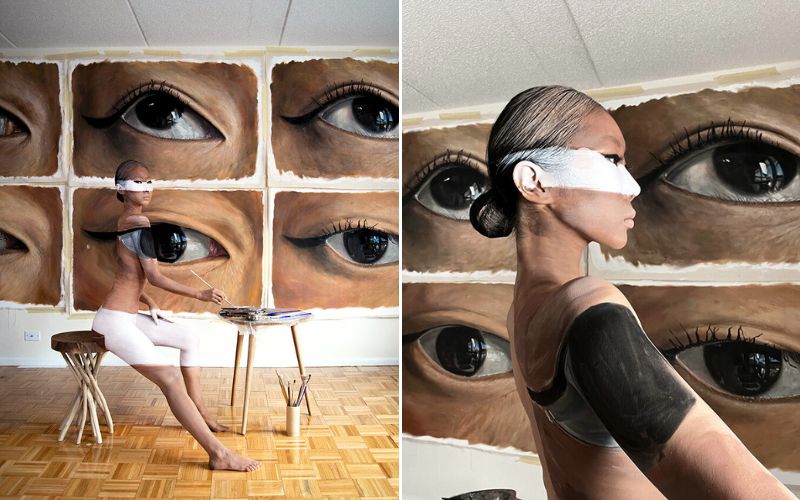
Though my dad is a professor specializing in architectural engineering, and engineers are often stereotyped as serious or detached, he is one of the most sentimental and lively people I know. He loves dancing, playing music, reading books, and more. The balance of traits from both my parents has shaped me into the artist I am today, and they will continue to influence my work in countless indirect ways.
When did you start painting on the human body, and what was your first design?
The first time I painted on a human body for my own work was during my sophomore year. I created designs featuring multiple faces and eyes on the bodies of models. Even before that, I was already familiar with painting on people through my experience doing theater makeup and hair for plays. Since my face and body paintings take a long time to complete, I often felt bad for the models who had to sit still for hours. That was one of the reasons I started painting on myself—at least then, I’d be the only one suffering, haha.
Back in college, one of my hobbies was modeling, so using myself as the model felt like a natural fit. I also usually photograph my own work, so by using my own skin as the canvas, I was able to create independently. It helped me focus deeply, especially during more emotionally sensitive times.
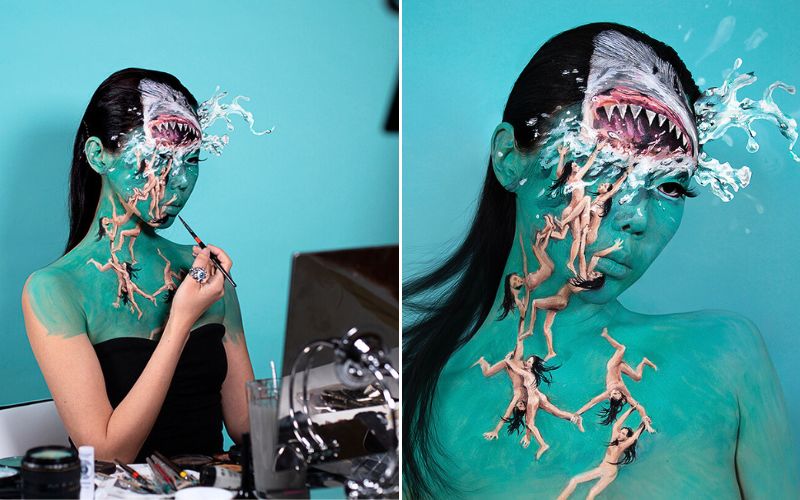
Could you explain your process of creating these illusions, and how long does it typically take you to complete one of your creations?
I usually start by brainstorming ideas and sketching out how I want to bring the design to life. Once the concept is clear, I move on to execution. The amount of time it takes depends on the complexity of the painting, but it usually ranges from 2 to 10 hours when painting on myself. For other works—like sculptures, paintings on canvas, or performances—the process takes much longer. One of my more ambitious recent projects was a series of 16 large oil paintings, which took about two years to complete.
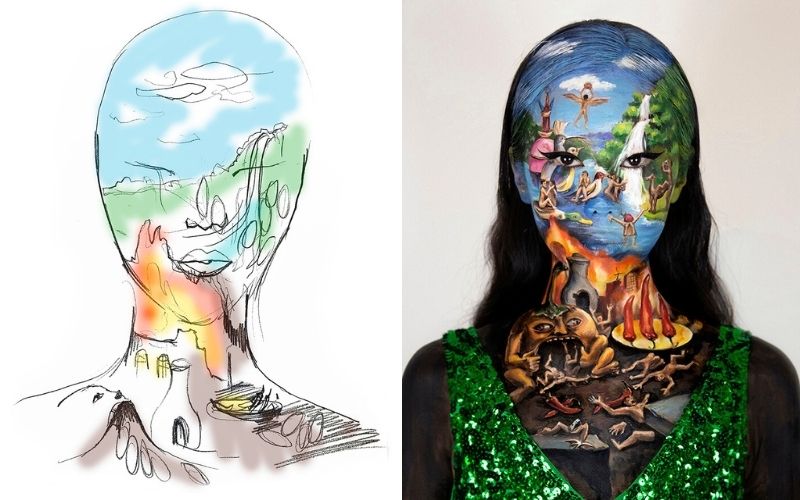
Also, my longest-term project is DainLapse, where I take a photo of myself and sign it every day. I strongly believe in the power of daily behavior. I thought instant film would be perfect for documenting this journey because I wanted to create a physical art piece each day. So far, I have more than 1,000 film selfies.

Your work often blends your body with backgrounds or landscapes. What is the philosophy behind this, and what does it mean for you to become part of the environment or setting in your art?
My motivation in creating camouflage paintings comes from wanting to play around with the idea that “all that you see may not be true — or may not be everything.” In other words, it encourages the viewer to confront the idea that not everything is always as it appears to be. Camouflage painting is also a unique format because it allows me to convey emotions and meaning through the choice of background that I blend myself into.
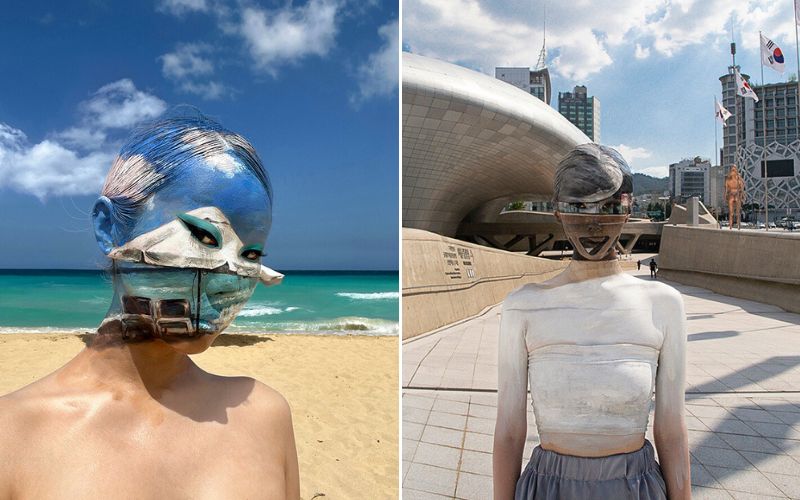
One of my favorite works in this genre is the one I painted at 만해한용운심우장 (Simujang, the former residence of Manhae Han Yong-un). A lot of people who see my works think I’m Korean American or someone who didn’t grow up in Korea, because the style of my work is somewhat untraditional. Maybe partly because of this, I often created works that show traditional Korean culture. Han Yong-un was a Buddhist reformer and poet, and from 1905 until his death, he devoted his life to the cause of Korean independence. I chose this place to show respect for his spirit, noble life, and beautiful literature. I lived close to that area when I was a teenager and visited there often, so it had a special connection to my childhood as well.
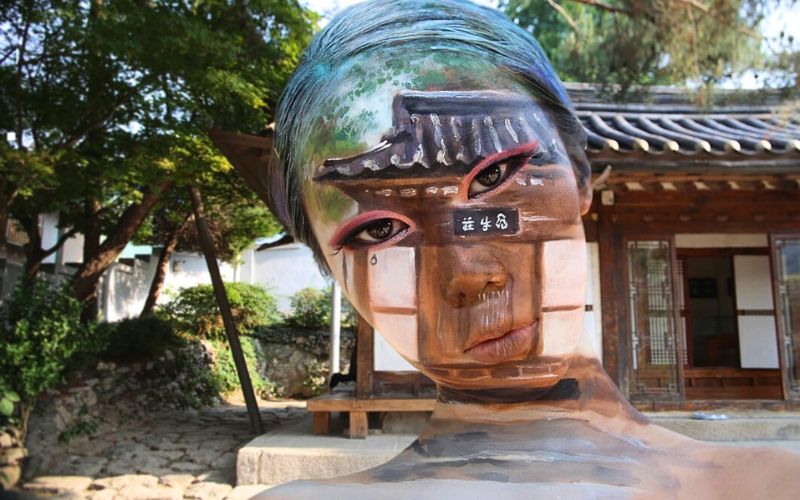
How do your Korean roots influence the way you approach color, texture, and design in your optical illusions, and do you find any particular connection between your artistic style and Korean aesthetics?
After making the difficult decision to immigrate to the United States alone, I started thinking much more deeply about Korean culture and how it has shaped who I am today. I was born and raised in Seoul city, and all the schools I attended had very competitive environments. As a teenager, it wasn’t always the healthiest atmosphere, but I tried to turn those difficult experiences into creative energy—and it worked for me. At that time, I was extremely sensitive about everything. I still am, haha, but now I’m better at handling my emotions. I had so many feelings I needed to express, which is why I created so many dizzying paintings in my early twenties. My work has always reflected my deepest emotions—sometimes in ways I only come to understand later. I used to say that I wouldn’t have been able to create my kind of art if I had been born by the sea or in a more peaceful place. But of course, in that case, I would be making completely different types of art shaped by different experiences.
Growing up and being trained in fine art painting in Seoul, my art style naturally draws on Korean culture and even some Korean painting techniques. I also find a lot of inspiration in older Korean artists. Living in New York City, I’ve appreciated the chance to see exhibitions featuring Korean artists, and I always make it a point to learn as much as I can from their work and artistic philosophy.
I am grateful that I have been able to experience a lot of different things than many people my age, and for me, all of these experiences—good or bad—are so valuable because I use all of them as my inspiration.
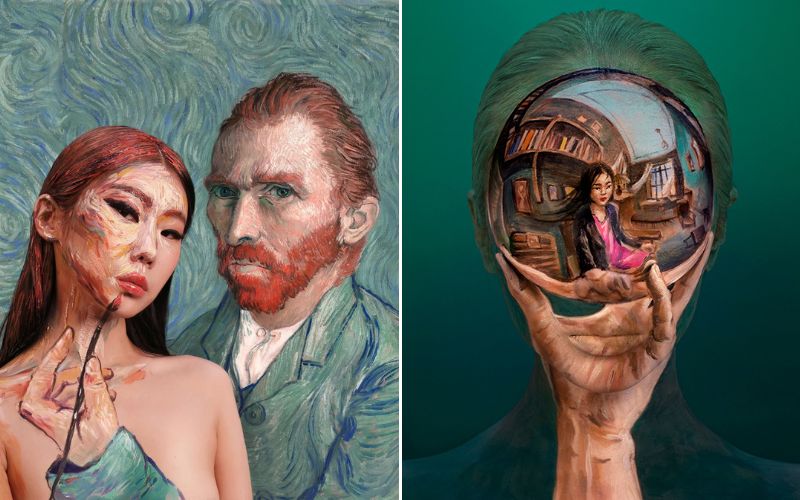
You recreate world-famous paintings on your face and body. What draws you to transform these iconic works into optical illusions on your own skin, and how do you approach incorporating such masterpieces into your art?
One of my favorite approaches to creating new works is to "make familiar things unfamiliar." For example, I like to take a well-known or classic piece and subvert expectations by recreating it in an unusual format or style. I also see this as a way of paying tribute to some of my favorite artists, as it pushes me to engage with the work on a much deeper level.
Which of your designs have been the hardest to erase, emotionally?
The ephemeral nature of face painting is one of its most unique aspects. Unlike a canvas, my physical works only exist for a very short time, which I believe enhances the emotions and meaning behind the piece. The designs take several days to create but removing them only takes a minute! It serves as an allegory for life—where the most meaningful things require immense effort to achieve but can be undone in seconds. In the beginning of my career, I felt uneasy about removing the paint, but now I remind myself of the importance of maintaining healthy skin and body, so it no longer feels difficult.
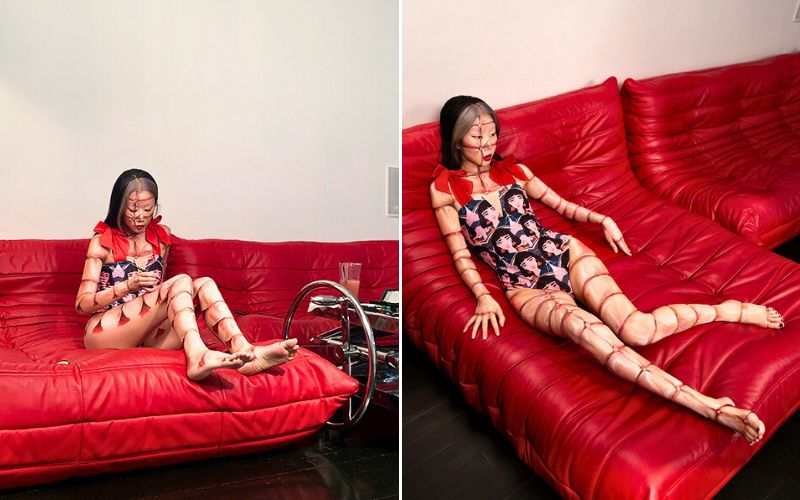
You have been featured in many renowned magazines and also on several popular TV shows with international reach having millions of viewers. What was it like to come to such a significant point in your career, and how do you feel about the global feedback you have received on your designs?
I am so grateful. There were so many things I dreamed of as a teenager that I was able to accomplish by my early 20s. I never imagined I would move and live in another country on my own to continue pursuing my work. I am truly thankful for the positive feedback and recognition that I have received from all around the world. It is this global appreciation of my work through social media and the internet that made all of this possible. I feel incredibly lucky to continue living as a working artist, despite the challenges, because I feel most like myself when I create. My art was never meant to attract attention or provoke a specific response. I am simply someone who needs to release my emotions through creative work in order to feel alive, and I consider myself fortunate that my art has gained the attention it has. I hold high expectations for myself, and that mindset keeps me moving forward.
How about this article?
- Like8
- Support0
- Amazing6
- Sad0
- Curious0
- Insightful1


